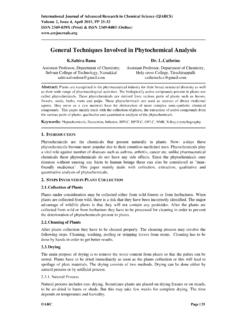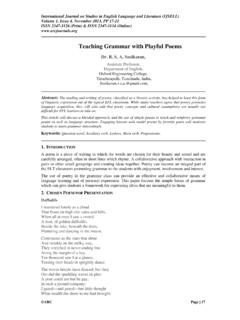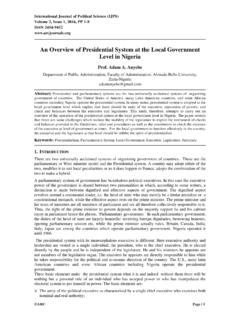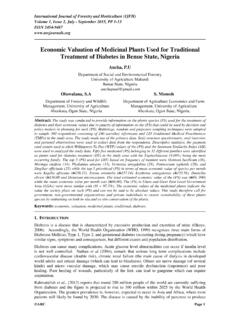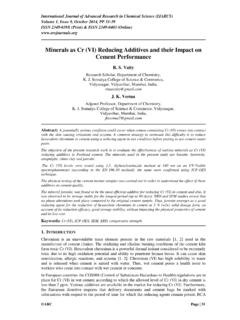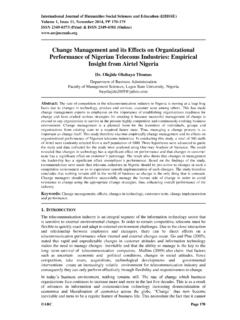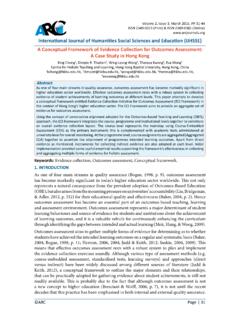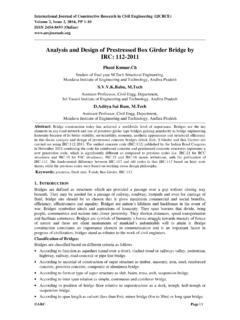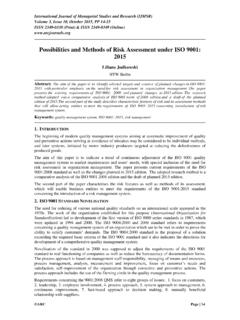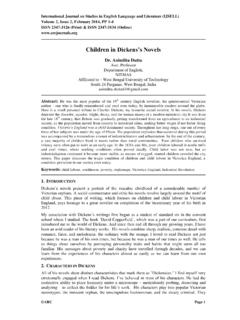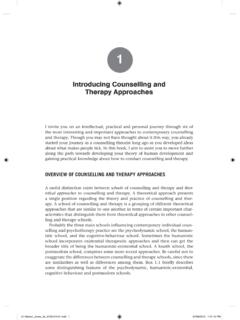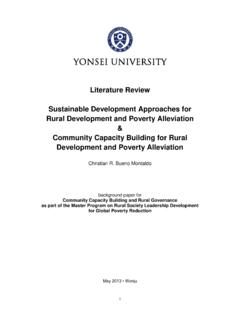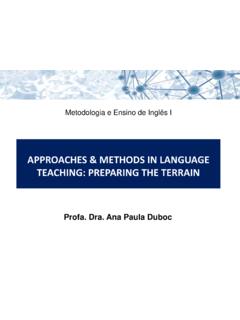Transcription of Principles, Theories and Approaches to Critical Discourse ...
1 International Journal on Studies in English Language and Literature (IJSELL). Volume 6, Issue 1, January 2018, PP 11-18. ISSN 2347-3126 (Print) & ISSN 2347-3134 (Online). Principles, Theories and Approaches to Critical Discourse Analysis Franck Amoussou1, Ayodele A. Allagbe2*. 1. D partement d'Anglais, Facult des Lettres, Langues, Arts et Communication (FLLAC) Universit d'Abomey- Calavi (UAC) Benin. 2. Laboratory for Research in Linguistics and Literature (LabReLL). *Corresponding Author: Ayodele A. Allagbe, Laboratory for Research in Linguistics and Literature (LabReLL), Benin Abstract: Critical Discourse Analysis (hereafter CDA) is a cross-discipline set forth in the early 1990s by a group of scholars such as Theo van Leeuwen, Gunther Kress, Teun van Dijk, and Norman Fairclough (Wodak & Meyer, 2001). Since the last decade or so, there has been a resurgence of the application of the theory of CDA to a range of studies (Bloor & Bloor, 2007; Bayram, 2010; Jahedi & Abudullah, 2012; Parham, 2013.)
2 Akogbeto & Koukpossi, 2015; Koussouhon & Dossoumou, 2015; Koussouhon & Amoussou, 2016; etc.).In view to spurring on the use of that research paradigm, the current study attempts to clarify what it means to say that one is doing Critical Discourse analysis. In that endeavor, it sheds light on the principles underlying the concept, the methods it draws on, as well as the focal Approaches to CDA that have thus far been put forth by prominent scholars. Keywords: Approach, Critical Discourse Analysis, Discourse Analysis, Paradigm, Theory. 1. INTRODUCTION. Critical Discourse Analysis (hereafter CDA) is a cross-discipline set forth in the early 1990s by a group of scholars such as Theo van Leeuwen, Gunther Kress, Teun van Dijk, and Norman Fairclough (Wodak & Meyer, 2001). At that time, Theories and methods of CDA have been formulated to differentiate this paradigm from other Theories and methodologies in Discourse Analysis.
3 Later on, the term has been known under many designations. While, according to their fields of research or areas of study, some scholars prefer the concept Critical Linguistics (CL), others choose to use the label Critical Discourse Studies (CDS). It follows from this to argue that CDA is an interdisciplinary approach which, as stated by Bloor and Bloor (2007), can be used by professionals from a variety of backgrounds such as historians, business institutions, lawyers, politicians, etc., to investigate social problems relating to their work. Since the last decade or so, there has been a resurgence of the application of the theory of CDA to a range of studies (Bloor & Bloor, 2007; Bayram 2010; Jahedi & Abudullah 2012; Parham, 2013;. Akogbeto & Koukpossi, 2015;Koussouhon & Dossoumou, 2015, Koussouhon & Amoussou, 2016; to name but a few). Although such research works provide the reader with valuable and pertinent results, some seem far from abiding by the elementary principles underlying the Critical approach they set out to apply.
4 In that sense, this research work intends to make it clear that a systematic application of some Theories like Systemic Functional Linguistics to a text or Discourse (as often recommended by CDA proponents) is not sufficient to claim the Critical stance of the study of the text or Discourse . As Wodak & Meyer (2009) put it, there are salient principles which are constitutive of all Approaches in CDA ( ). The current endeavor attempts then to clarify what it means to say that one is doing Critical Discourse analysis. In that perspective, the following research questions are posed: what is CDA? Can any analysis of Discourse , assuming that language is social and political, be considered as a CDA? To what extent does CDA differ from other types of Discourse analysis? What aspects of language are important to analyze in conducting CDA? How do we assess the validity and trustworthiness of research on CDA?
5 The subsequent sections will try to provide answers to these questions. International Journal on Studies in English Language and Literature (IJSELL) Page | 11. Principles, Theories and Approaches to Critical Discourse Analysis 2. FEATURES OF CDA. This section is concerned with underlining the main tenets that characterize CDA. In that respect, it will first highlight the difference between CDA and other kinds of Discourse analysis. Then, the basic assumptions of CDA are going to be highlighted. CDA and Other DA Approaches As may be guessed from the label of each of the two concepts, CDA and DA ( Discourse Analysis) do not mean the same thing. DA is a series of interdisciplinary Approaches that can be used to explore many different social domains in many different types of studies (J rgensen and Phillips, 2002:12). This means that Discourse analysis can be applied to all areas of research, with a method of analysis intrinsically linked to its theoretical and methodological foundations.
6 Brown & Yule (1983:26) argue that doing Discourse analysis involves not only doing syntax and semantics , but also doing pragmatics . It follows from this that the context of occurrence of a piece of Discourse should be of particular interest to the Discourse analyst. As for CDA, it focuses on social problems, and especially on the role of Discourse in the production and reproduction of power abuse or domination (van Dijk, 2001:96). CDA, then, sets up a relationship between language and power. In that sense, Wodak (2001) regards it as fundamentally concerned with analyzing opaque as well as transparent structural relationships of dominance, discrimination, power and control as manifested in language. Concerning the difference between CDA and DA, Rogers (2004:3) claims that CDA differs from other Discourse analysis methods in that it includes not only a description and interpretation of Discourse in context, but also offers an explanation of why and how discourses work.
7 Wodak (2001) claims that the differences between CDA and other DA, pragmatic and sociolinguistic Approaches may be most clearly established with regard to the general principles of CDA. In that regard, Fairclough and Wodak (1997, cited in van Dijk, 1993) set forth eight foundational principles of CDA which, as viewed by Rogers (2004), are a useful starting point for researchers interested in conducting CDA . These principles are underscored in the following subsection. But for the moment, it is expedient to explain what makes CDA Critical , that is to elucidate the Critical side of the concept. In normal parlance, the word Critical denotes the habit of evaluating an object or situation in accordance with a system of rules, principles and values (Locke, 2004). Within CDA perspective, Critical is not to be understood in the common sense of the word, , criticizing, or being negative. In a conversation best owed to Kendall Gavin, Wodak (2001) claims that Critical means not taking things for granted, opening up complexity, challenging reductionism, dogmatism and dichotomies, being self-reflexive in one s research, and through these processes, making opaque structures of power relations and ideologies manifest.
8 Critical , thus, does not imply the common sense meaning of being negative -rather skeptical . Proposing alternatives is also part of being Critical (Kendall, 2007). Rogers (2004:3) believes that within this framework of Critical , the analyst s intention is to uncover power relationships and demonstrate inequalities embedded in society. Basic Assumptions, Aims and Definition It is paramount to signal at the outset of this subsection that it is not easy to precisely delimit the special principles, practices, aims, Theories or methods of CDA (Van Dijk, 1995). Yet, any research work which claims to be of the CDA paradigm should be characterized by some basic criteria. Those criteria, originally defined by Kress (1990), are taken further by Fairclough & Wodak (1997) who establish some basic principles of a CDA programme (Cf. Wodak, 2001:5). Critical research on Discourse , Van Dijk (2003) argues, needs to satisfy a number of requirements in order to effectively realize its aims: It is problem-or issue-oriented: any theoretical and methodological approach is relevant as long as it is able to successfully study relevant social problems such as sexism, racism, and other forms of social inequality.
9 In order to study social problems or issues adequately, CDA work is typically inter- or multidisciplinary, and especially focuses on the relations between Discourse and society;. CDA does not characterize a school, a field or a sub-discipline of Discourse analysis, but rather an explicitly Critical approach, position, or stance of studying text and talk. International Journal on Studies in English Language and Literature (IJSELL) Page | 12. Principles, Theories and Approaches to Critical Discourse Analysis CDA especially focuses on (group) relations of power, dominance and inequality and the ways these are reproduced or resisted by social group members through text and talk;. Much work in CDA is about the underlying ideologies, that play a role in the reproduction of or resistance against dominance or inequality;. CDA studies are geared to uncovering, revealing or disclosing what is implicit, hidden or otherwise not immediately obvious in relations of discursively enacted dominance or their underlying ideologies.
10 That is, CDA especially focuses on the strategies of manipulation, legitimation, the manufacture of consent and other discursive ways to influence the minds (and indirectly the actions) of people in the interest of the powerful;. This attempt to uncover the discursive means of mental control and social influence implies a Critical and oppositional stance against the powerful and the elites, and especially those who abuse of their power;. On the other hand, studies in CDA try to formulate or sustain an overall perspective of solidarity with dominated groups, , by formulating strategic proposals for the enactment and development of counter-power and counter-ideologies in practices of challenge and resistance. As stated above, Fairclough & Wodak (1997) draw on the aforementioned criteria and set up eight basic principles or tenets of CDA as follows: (i) CDA addresses social problems; (ii) power relations are discursive; (iii) Discourse constitutes society and culture; (iv) Discourse does ideological work; (v).
